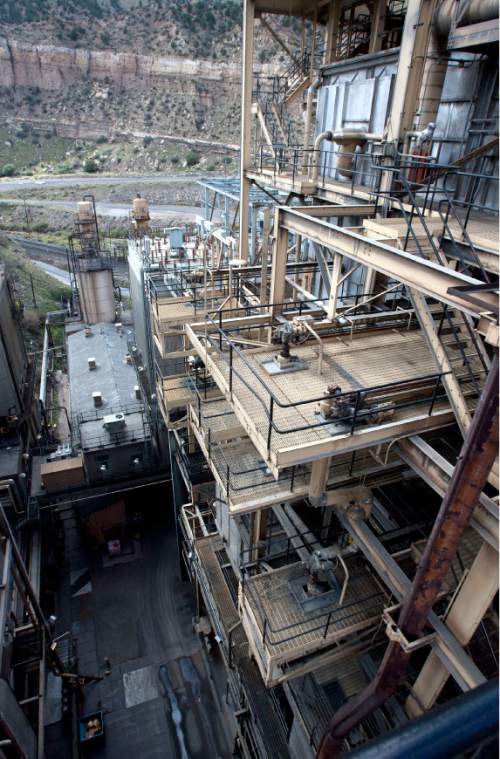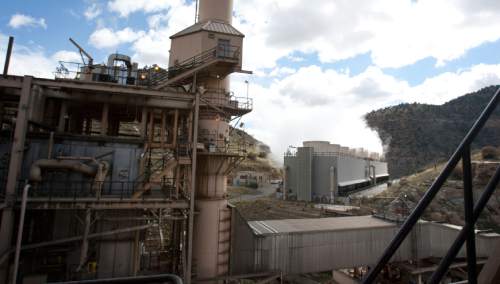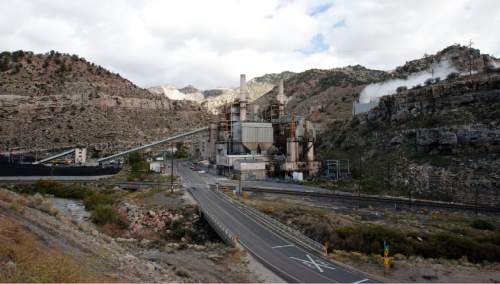This is an archived article that was published on sltrib.com in 2016, and information in the article may be outdated. It is provided only for personal research purposes and may not be reprinted.
A flash flood Thursday afternoon cut through a massive repository of coal ash outside Helper and pushed unknown quantities of the waste into the Price River.
Over the past six decades, Rocky Mountain Power has filled a side canyon to Price Canyon, just downstream of its Carbon Power Plant, with the plant's ash. The plant was retired in April 2015, and the power company has been in the process of grading and capping the ash pile for permanent closure.
But a cloudburst Thursday sent floodwaters down Panther Canyon, overwhelming stormwater systems. Paul Murphy, a spokesman for Rocky Mountain Power (RMP), said the company is installing landfill safeguards — construction crews were on site when the flood hit — designed to withstand a storm so big that, statistically, it only happens once every 100 years.
Those controls diverted some of the stormwater away from the landfill, he said, until "very intense flooding" filled a culvert with debris.
The blockage allowed some of the runoff to flow directly into the landfill, where it cut a canyon-like path through the ash, according to Scott Hacking, an environmental engineer with the Utah Department of Environmental Quality (DEQ).
"It is extremely bad timing," Hacking said. "It doesn't appear to be major quantities, but I would call it significant enough that we ought to be concerned and the river should be sampled."
Brian McInerney, a hydrologist with the National Weather Service, said the Price area did appear to have experienced flash flooding on Thursday, but that the limited data available did not suggest anything out of the ordinary. The landfill in question is located in a spot not visible to National Weather Service radar, and McInerney said he did not have any observational data from rain gauges in the area. However, he said more general data indicate that sporadic storm activity dropped as much as 1 to 1.5 inches of rain in the space of an hour in some places throughout south-central Utah. He said he would assume the Price area experienced similar conditions.
While anything over an inch of rain per hour is capable of producing a flash flood, McInerney said that rate of rain isn't unusual in Price this time of year. In order to produce an abnormally large flash flood, he said, Price would need to get more than 2 inches of rain per hour.
"Based on what we saw, it was not atypical for this time of year," he said. "But since we don't have the actual data, we can't actually say — unless someone had a rain gauge."
Coal-fired generating stations produce vast amounts of ash, which are usually stored in nearby repositories. This ash contains heavy metals, so the piles must be managed carefully to ensure they don't harm the environment. Ground and surface water are particularly at risk.
Advocacy groups HEAL Utah, the Sierra Club and Public Justice filed a federal lawsuit in March, saying RMP has been "negligent" in its handling, transport and disposal of ash at the nearby Huntington plant.
"Yet again, public health and the environment have been threatened by Rocky Mountain Power's careless handling of dangerous coal ash," said Matt Pacenza, HEAL Utah's executive director. "Whether it's storing it in a site vulnerable to flooding right next to the Price River, or spraying coal ash-contaminated water on fields next to Huntington Creek, the utility's negligence should definitely worry Utahns."
The Carbon ash fills a canyon visible from U.S. Highway 6 on the eastern side of the river about a mile or two above Helper. Containing millions of tons of ash, the pile is equipped with a 48-inch culvert for diverting stormwater around the pile. Below is a retention pond sized for the hypothetical 100-year storm, according to a DEQ spill report.
But flood debris clogged the culvert's trash rack, directing water over the ash, where it cut a gash 10 to 20 feet wide and 3 feet deep, Hacking said. The ash-laden water then overflowed the pond and entered the river.
"It wasn't as bad as it could have been," Hacking said. "Everything performed as it should for the first two-thirds of the event."
As of Monday, the amount of ash discharged into the river was unknown, but clean-up at the site was progressing well, according to Donna Spangler, a spokeswoman for the DEQ. The results of samples collected on Friday to assess whether the spill increased heavy metals concentrations in the Price River are not expected until Thursday.
Meanwhile, Spangler said, there doesn't appear to be an imminent threat, because the flood waters appear to have diluted the ash that washed into the river.
The Price River was a raging torrent over the weekend, mobilizing and flushing most if not all of the coal waste down the river, which flows past Price and empties into Green River.
"There is not much left to sample," Hacking said.
The spill is not expected to affect drinking water supplies because Price city's intakes are upstream of the Carbon plant.







